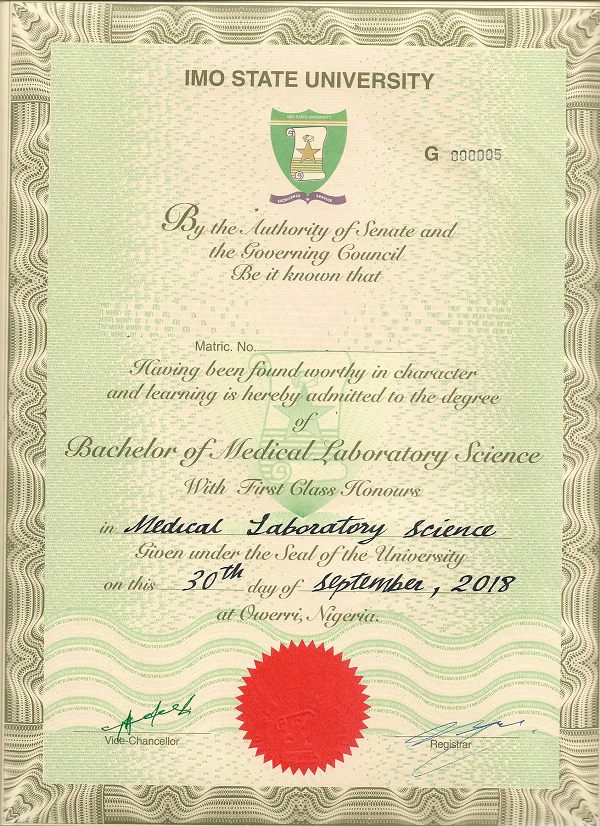Medical Laboratory Science
Histological Effect Of Carpet Grass Extract On The Spleen Of Albino Rats
ABSTRACT
The histomorphological effect of Axonopus fissifolius leaf extract on the spleen of an albino rat was determined. The leaves were collected, washed thoroughly with distilled water, they were subsequently dried with hot air oven and comminuted using a grinding machine. Adult albino rats of both sexes, weighing between 201 g and 225 g were used for this study. Twenty healthy albino rat (male and female) acclimatized were weighed and randomly distributed into four different groups of five (5) in each. The groups were group A-D. Group A served as the control group and received pellet and water only, group B was treated with a dose of 100mg/kg of the extract, group C a dose of 200mg/kg and group D treated with a dose of 300mg/kg. The extract was dissolved in water and was administered once daily orally and slowly to the healthy for three (3) weeks using orogastric tube. The animals were sacrificed by cervical dislocation, the spleen were removed and preserved in buffered 10 % formalin saline solution for histopathological processing. There were no significant differences in the body weight of the control animals and those who received Axonopus fissifolius leaf extract, the p value was > 0.05. No histological alterations were observed in animals treated with 100mg/kg. Examination of the kidney sections of rats treated with 200mg/kg and 300mg/kg of Axonopus fissifolius Leaf extract showed enlarged and congested splenic capsule and veins. Leucocytic infiltrations were observed in the sinusoids. grass leaf extract plays an important role in the amelioration of a diseased condition. Carpet grass also plays an important role in the purification of the splenic cells when consume in moderate concentration it also restores damaged cells back to its normal morphology. But an over dose of carpet grass leaf extract should be avoided because of it adverse effect on the histology of the spleen.
CHAPTER ONE
1.0 INTRODUCTION
Carpet grass (Axonopus fissifolius), mat-forming perennial grass of the family Poaceae, native to sandy soils in southeastern North America. Carpet grass is occasionally used as a lawn and pasture grass in warm areas, but its use generally indicates declining soil fertility, because it is a low-quality forage (Feedipedia, 2015). The plant has naturalized in many parts of the world.
Carpet grass reaches a height of 20–50 cm (8–20 inches). Its roots are very shallow; the plant spreads vegetatively with both rhizomes and stolons. The minute wind-pollinated flowers are borne in small panicles (compound spikes) with three or four branches (Heuzé et al., 2016). They seed profusely. Broadleaf carpet grass (A. compressus) is a closely related species native to South Africa. It too is used for lawns, though both species are often considered weeds.
Carpet grass is also great for erosion control. Any patch of land that you’re not ready to work with yet but would like to keep from eroding away will do well to have a patch of carpet grass grown on it to keep it safe until you’re ready to work with it (Cowell, 2009). The thick sod of carpet grass keeps weeds to a minimum too, meaning you won’t come back to the site and find that there’s been an infestation of Bermuda grass or other weeds.
The importance of medicinal plants and traditional health systems to solve the problems of health care in the world is gaining more and more attention, unfortunately a lot of Nigerian consumed this leaf without having knowledge of the possible side effects of the vegetable. In the study carried out by Onwuka et al., (2017) they found out that the methanolic extract of Axonopus fissifolius have an ameliorative effect on gastric ulcer, while some study report that Axonopus fissifolius when consumed causes gastro-intestinal disturbances.
The spleen plays important roles in regard to red blood cells (erythrocytes) and the immune system (Mebius and Kraal, 2015). It removes old red blood cells and holds a reserve of blood, which can be valuable in case of hemorrhagic shock, and also recycles iron. As a part of the mononuclear phagocyte system, it metabolizes hemoglobin removed from senescent red blood cells (erythrocytes). The globin portion of hemoglobin is degraded to its constitutive amino acids, and the heme portion is metabolized to bilirubin, which is removed in the liver (Mebius and Kraal, 2015).
There is limited knowledge on the negative effect of phytochemicals as an injurious substance, the spleen is actively involved in the removal of dead red cells from the body, and some of the substances found in natural herb are injurious to the spleen, causing a distortion to the histomorphology of the spleen. When the spleen is been subjected to this injurious substance for a long period of time, there is a likely tendency that inflammation of the spleen may occur which may lead to spleen disease. Carpet grass is consumed without the knowledge of the dose that is suitable for the body normal function, thereby predisposing the spleen to damage.
1.1 Justification
Herbs play a role in the management of various organ disorders, most of which speed up the natural healing processes of the diseased organ (Rama et al., 2016). Since ancient times, people have been exploring nature, particularly plants, in search of new drugs, and this has resulted in the use of a large number of medicinal plants with curative properties to treat various diseases (Rama, et al., 2016). While several report has it that, carpet grass leaf extract has been used to fight infections, lower blood cholesterol and triglyceride levels, and for weight loss, clinical trials are generally lacking for therapeutic applications, and the harmful effect of an overdose of the drug. Therefore the purpose of this study is to investigate the histological effect of Axonopus fissifolius leaf extract on the spleen of an albino rat.
1.2 Aim and Objectives
Aim
The aim of this study is to investigate the histological effect of Axonopus fissifolius leaf extract on the spleen of the albino rat.
Objectives
The specific objective of this study is as follow:
- To investigate the effect of Axonopus fissifolius leaf extract on the histology of the spleen of the albino rat.
- To investigate the effect of Axonopus fissifolius leaf extract on weight changes of the albino rat.
Pages: 62
Category: Project
Format: Word & PDF
Chapters: 1-5
Source: Imsuinfo
Material contains Table of Content, Abstract and References.
await loadScriptWithTimeout(scriptUrl, TIMEOUT_MS); } catch (_) {} })();
-

 IMSU News4 years ago
IMSU News4 years agoIs It Worth Registering a Pre-degree Program In IMSU? All you need to know about IMSU Pre-degree
-

 IMSU News5 years ago
IMSU News5 years ago7 Popular department in Imo State University (IMSU)
-

 IMSU News2 years ago
IMSU News2 years agoIMSU reprinting for 2023/2024 post UTME candidates has commenced
-

 IMSU News4 years ago
IMSU News4 years agoSteps on How to Apply for Certificate in Imo State University, Owerri (IMSU)

